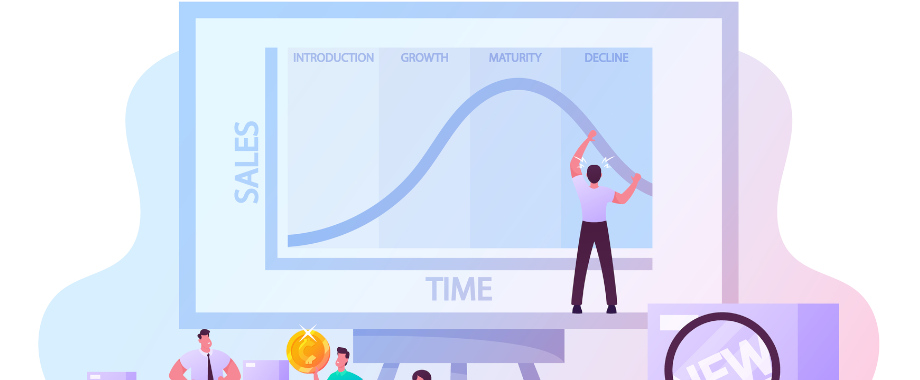
Table of Contents
There are, in fact, two Product Life Cycle Management models. One refers to marketing and the other to engineering. The engineering life cycle deals with product development, but we’re about to discuss the long-established marketing model.
Definition of Product Life Cycle Management
The concept of the Product Life Cycle has been around since the 1950s. The representative research was published by T. Levitt in his paper “Exploit the product life cycle” (Harvard Business Review, 1965). The research established that a product, like a living being, experiences a life cycle comprised of stages, similar to birth, growth, maturity, and decline. This implies that you can predict the life cycle stage of your product and then apply Product Life Cycle Management to it. The theory was actively elaborated and employed in the 1980s, but by the 1990s, there were few academic contributions and no additional research offered to augment the theory.
Product Life Cycle Management is the sequence of marketing strategies recommended for each stage of a Product Life Cycle to optimize its promotion and manufacturing plans. This concept is applied to products, product forms, and product classes.
Goals
The main goal of the PLM concept mirrors the goal of each marketing theory - to produce a highly profitable, long-lasting product that outperforms its competitors.
PLM is intended to
- improve product quality,
- reduce time to market,
- identify potential sales opportunities and revenue contributions,
- increase the return on investment from promotional campaigns,
- timely discontinuation of the product.
Benefits
The product life cycle concept is used to estimate the current situation, forecast the behavior of the market and apply the best strategies for the given stage. It simplifies the decision-making process. The application of product life cycle management results in the following benefits:
- increased revenue,
- reduced costs,
- reduced time to market,
- high return on advertising investments,
- maximized product value throughout the product’s life cycle,
- extended product lifetime,
- decreased compliance risks.
The Product Life Cycle Management at each stage
In the original concept, just 4 life cycle stages were described. Though, later the PLC theory was extended and updated. Some sources describe 5 stages. We consider the 6-stage model the most complete.
Product development stage
Though this stage was not a part of the original concept, it is an important part of the product life cycle. This is because, today, marketing strategies are already well-developed at this stage. Product development also includes its own sub-stages which includes advancing ideas for new products, design, and realization (or manufacturing).
The stages in the product design and development process form a life cycle of their own. The development phase involves considerable cost for the company. But the invested funds return only if the product is released and sold. Specialized PLM software has been developed to facilitate this stage. It offers more effective engineering and manufacturing during product design and development. Marketing activity and demand creation are both established at this stage.
Product introduction stage
During product introduction, there is no competition, as the product is new, but there is also, generally, no demand and sales are low. Marketing costs are high as you introduce the product to the market. The main goal is to reach early adopters.
Your marketing strategy, at this stage, should focus on building demand for the product, so promotion is the primary objective and should receive most of your attention. Now you also have to develop distribution channels and establish and adjust pricing.
Product growth stage
Sales are growing. It’s easier to establish new distribution channels. Revenues increase.
At the same time, competitors appear. Now, the main task is not to convince people to try the product but to establish the brand and make its name more recognizable.
The best strategy is to invest in increasing brand awareness to reach the “early majority” audience. It has also become important to establish long-term relationships with as many distribution channels as possible. Usually, at this stage, the company creates new variants of the product (new models, colors, flavors, etc.)
Product maturity stage
In maturity, the product is already well-known. The sales are either rising at a much slower pace or have reached a plateau. The competition is usually very aggressive and price-driven. Revenues are high. Many companies manage to prolong the maturity stage for decades.
Here, the recommended strategy includes price reduction and discounting, and diversification of the product. Companies should seek to conquer new markets and locations, and target new customer groups. Some companies even invent new ways to use the product, like nylon producer, DuPont. Nylon was originally used by the military, but later DuPont started to make stockings from it.
Product saturation stage
Now the market is saturated. The competition is very high and the prices are low. Sales start to drop. At this time, companies usually start preparing their exit strategy. Marketing, at this stage, is reduced to advertising costs as the product no longer has a significant impact on profits. It becomes important now to plan production carefully to avoid obsolete products and components when you discontinue the product.
Product decline stage
Sales are dropping dramatically. Product demand is practically absent. Profitability falls, until it reaches the point where the product is no longer profitable. The marketing strategy at this stage is to discontinue the product. Some companies continue production at very low volumes to use the remaining components and avoid obsolescence.
The best strategy for a company, in general, is to release a new product when discontinuing the product in its decline stage. This is why it’s wise to start developing a new product when the current product reaches maturity.
Conclusion
Product Life Cycle Management is a concept that prescribes a set of marketing actions at each stage of product life. These stages are Development, Introduction, Growth, Maturity, Saturation, and Decline. Reasonable investments in advertising, distribution, and proper pricing allow a company to obtain the maximum benefit from the product. In the end, timely discontinuation avoids unnecessary expenses.


